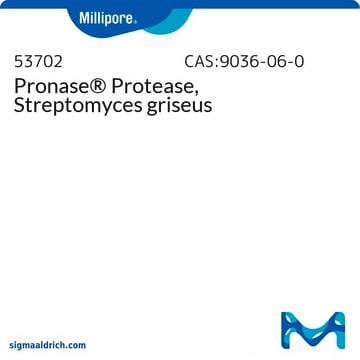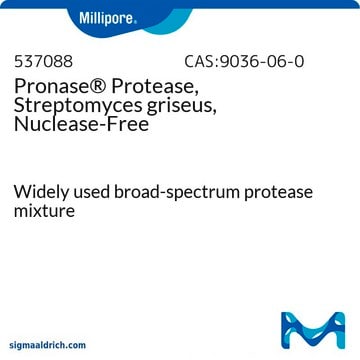There is no specific information available about storing the enzyme at -80°C once it has been reconstituted.
P5147
Proteasi
Type XIV, ≥3.5 units/mg solid, powder
Sinonimo/i:
Actinasi E, Pronasi E
Scegli un formato
Scegli un formato
About This Item
Prodotti consigliati
Origine biologica
Streptomyces griseus
Livello qualitativo
Tipo
Type XIV
Stato
powder
Attività specifica
≥3.5 units/mg solid
Solubilità
10 mM NaAc (pH 7.5) and 5 mM CaAc: soluble 0.2 mg/mL at 37 °C, clear, colorless to tan
Condizioni di spedizione
wet ice
Temperatura di conservazione
−20°C
Cerchi prodotti simili? Visita Guida al confronto tra prodotti
Categorie correlate
Specificità
Applicazioni
- per la digestione del tessuto del nucleo polposo (NP)[1]
- nella catalisi della reazione asimmetrica di Mannich one pot[2]
- per la deproteinizzazione dell′amido[3]
- digestione di sezioni di cervello per la dissociazione cellulare[4]
Azioni biochim/fisiol
Caratteristiche e vantaggi
- molto stabile a pH compreso tra 5,0 e 9,0, con picco di attività a pH 8,8
- compatibile con molti tamponi per l′isolamento di DNA e RNA
- ampia specificità per il substrato
Qualità
Proprietà fisiche
Definizione di unità
Nota sulla preparazione
Prodotti correlati
Avvertenze
Danger
Indicazioni di pericolo
Consigli di prudenza
Classi di pericolo
Eye Irrit. 2 - Resp. Sens. 1 - Skin Irrit. 2 - STOT SE 3
Organi bersaglio
Respiratory system
Codice della classe di stoccaggio
11 - Combustible Solids
Classe di pericolosità dell'acqua (WGK)
WGK 2
Punto d’infiammabilità (°F)
Not applicable
Punto d’infiammabilità (°C)
Not applicable
Dispositivi di protezione individuale
Eyeshields, Gloves, type N95 (US)
Scegli una delle versioni più recenti:
Certificati d'analisi (COA)
Non trovi la versione di tuo interesse?
Se hai bisogno di una versione specifica, puoi cercare il certificato tramite il numero di lotto.
Possiedi già questo prodotto?
I documenti relativi ai prodotti acquistati recentemente sono disponibili nell’Archivio dei documenti.
I clienti hanno visto anche
-
Is it possible to store P5147 at -80°C after reconstitution?
1 answer-
Helpful?
-
-
Under what conditions can Product P5147, Protease from Streptomyces griseus, be used to digest protein?
1 answer-
For DNA isolation, Pronase E is usually prepared as a stock solution, and prior to storage at -20°C, the solution is first heated to 56°C for about 15 minutes, then incubated at 37°C for 1 hour. This encourages self-digestion, to eliminate DNAse and RNAse contamination. The enzyme is added to a DNA sample (in the presence of 0.5-1%(w/v) SDS to disrupt DNA protein interactions) typically at 250-500 μg protein/mL, then incubated at 37°C for 1-4 hours. For protein hydrolysis, dissolve about 0.2 μmol of protein in 0.2 mL of 50 mM ammonium bicarbonate buffer at pH 8 (or phosphate buffer pH 7). Add Pronase to 1% (w/w) and incubate at 37°C for 24 hours. It may be necessary to add aminopeptidase M at 4% (w/w) and incubate at 37°C for another 18 hours.
Helpful?
-
-
What is the Department of Transportation shipping information for this product?
1 answer-
Transportation information can be found in Section 14 of the product's (M)SDS.To access the shipping information for this material, use the link on the product detail page for the product.
Helpful?
-
-
Does Product P5147, Protease from Streptomyces griseus, contain calcium acetate?
1 answer-
This product contains calcium acetate buffer salt. The amount of calcium acetate present will vary for each lot number and has been observed to range from 2 - 30% (w/w).
Helpful?
-
-
Is Product P5147, Protease from Streptomyces griseus, also described as "Pronase"?
1 answer-
"Pronase E" is the name given to a group of proteolytic enzymes produced by Streptomyces griseus K-1. At least 10 proteases are in the mixture, five serine-type proteases, two zinc endopeptidases, two zinc leucine aminopeptidases, and one zinc carboxypeptidase.
Helpful?
-
-
How should Product P5147, Protease from Streptomyces griseus, be reconstituted and how should a stock solution be prepared?
1 answer-
This product can be dissolved in 0.01 M sodium acetate with 0.005 M calcium acetate at pH 7.5 at 37°C; at 0.2 mg/mL, this yields a clear solution which ranges from colorless to light tan. Calcium ion is recommended for protection from autolysis. The activity of a dilute enzyme solution containing 0.01 to 0.1 M calcium ion was stable over 24 hours at neutral pH at 2-8°C. Pronase E is stable at 4°C for at least six months. Stock solutions of 5 to 20 mg/mL in water are usually stored at -20°C.
Helpful?
-
Active Filters
Il team dei nostri ricercatori vanta grande esperienza in tutte le aree della ricerca quali Life Science, scienza dei materiali, sintesi chimica, cromatografia, discipline analitiche, ecc..
Contatta l'Assistenza Tecnica.















